11th Anniversary Celebration

Seems like only yesterday, but March 1, 2011 marks the 11th Anniversary of Wildbird & Backyard. We’re celebrating and we want to share this happy occasion with you! We’re bringing out the Discount Dice (by popular demand) and with every purchase during the month of March you will have 2 chances to shake a total of “11” on the dice. If successful, we’ll be happy to present you with an $11 Gift Card toward a future purchase. Come in and join our celebration---bring your luck with you and walk away with a gift from us. Tremendous thanks to all of you for your patronage and friendship over the past 11 years and for many more years to come.
Get Ready for Courtship - Putting Up Your Birdhouses
Approximately 85 species of North American breeding birds select or construct a cavity for their nesting. Some will look for nesting opportunities in the cavities of dead or dying trees, but most will appreciate your assistance with man-made boxes. Man-made houses are primarily used by the secondary cavity-nesters that select an available cavity, not a species that build their own house. Cavity-nesters range in size for the Chickadee to the Turkey Vulture, so a lot of choices are available for people interested in helping birds.
The success of a bird house is often related to a few simple decisions related to box size, entrance hole size, box placement, predator proofing, available feeding habitat, available escape cover, avoidance of known hazards and LUCK.
Before a house is selected, consider the type of bird you will try to attract. What types of birds frequent your yard and feeders? Remember, you are only providing the “nursery”; the bird still needs to be close to the “kitchen” for adequate food for the adults and young.
Placement is next. The house needs to be accessible (to you) for cleaning each fall. They should be cleaned each year after the nesting season. Height placement decisions are based on the species. For example the bluebirds prefer boxes at a 4 to 6 foot height; the chickadee seems to prefer 4 to 15 feet. Much has been debated about direction of the hole, we suggest using common sense. Usually in our northern climate a south facing hold might actually help keep the inhabitants warm.
Other pointers:
1 – The entrance hold should not face a busy street or highway as the adults flying to and from the nest risk being hit by a fast moving car.
2 – The box should not be in a major human use area. Adult birds are reluctant to select a box in an area with lots of disturbances.
3 – The box should be near escape cover so when the young fledge they can hide and not be eaten by a house cat before developing strong flight capabilities.
4 – Another consideration is the likelihood of predation. Precautions are warranted regarding the hole size. Bluebirds will nest in a box with 1 9/16 inch hole – any bigger hole will allow the European Starling to evict the bluebirds. The same is true with the Chickadees—if the hole is larger than 1 1/8 inch, House Sparrows will probably be using the box. If a nest hole is enlarged by woodpeckers or squirrels, then the front panel needs to be replaced or covered with the correct sized hole guard.
Wildbird & Backyard has a large selection of bird houses, ones to meet your individual taste and requirements. Sizes and holes range from chickadee size to those preferred by Wood Ducks. We’ll help you find the right sized hold for your favorite backyard visitors. Click here to check out just some of our many houses.
Welcome Spring and new Spring Arrivals
Weather Vanes
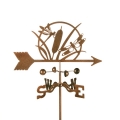
Weathervanes can be both decorative and functional. The earliest referenced weathervane appears to be the image of Triton from Ancient Roman times at approx. 50 B.C. As time moved forward typical images were usually animal shapes but today you can find almost any design on a weathervane. They are decorative as well as functional with arrows or pointers to show the direction of the wind.
Check out our new weathervanes, made right here in the USA. They are 14 gauge steel with a one year warranty on the finish and a lifetime warranty on all workmanship. They have a durable, scratch resistant finish, sealed ball bearings and are available in your choice of a 60" garden stake, a roof mount, a deck mount or a post/fence mount. We have stocked garden and bird designs but with over 150 designs available, we’ll be happy to special order a design of your choice for an additional $10 charge to cover the shipping. Click here to see a small sampling of some the great designs available.
Gourds and Gourd Houses
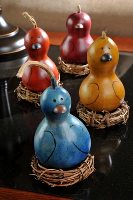
We discovered these gorgeous, well made gourds during our recent market trip. These amazing gourds are hand crafted in the Blue Mountain region in central Pennsylvania, USA grown, USA made. They begin from a special hard shelled gourd that is dried, cleaned, crafted, sealed, painted and decorated into a piece of art. The birdhouses have the correct opening either for songbirds or bluebirds, the butterfly gourds are correctly suited for butterflies. We have them in assorted colors. And for the cutest little conversation piece, we have assorted “Tweeters” (pictured on left) for decoration inside your home.
Garden Statuary

How about something new and colorful for your backyard decorating? New to our store are some small critters, the type who won’t bother your feeders or eat your plants! Whimsical and charming, we have a number of new additions to our statuary offerings. These are just two of our new crew. Arriving soon: snails, toads, colorful worms, and other “oh-so cute” little accents. Also, coming soon are some granite owls in several sizes– a must to see to appreciate, hand carved, true pieces of beauty and conversation..
Dove Proof Feeder
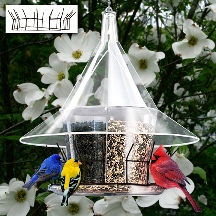
The Sky Café Dove Guard is an accessory for the Sky Café Classic feeder, a perfect solution for those who prefer not to feed the doves. This 1.5 gallon capacity Classic feeder has easy-flow seed dispensing which means birds peck at a seed and it falls out in front of them onto the tray for easy dining. There is a huge 17” diameter dome that protects the seed from rain, snow and squirrels. The Dove Guard is an added component, 12” in diameter, that comes with attaching strap locks to attach to the tray. Made from coated wire, it has a manufacturer’s lifetime warranty against squirrel damage. Made in the USA. Read more about this feeder and other accessories by clicking here.


After repeated efforts to introduce the bird, the European Startling was finally successfully brought to New York City. It was on March 16 1891, when a wealthy New Yorker with a strong passion for the birds of Shakespeare decided to import the starlings into New York City’s Central Park. The starling began to breed almost immediately after being released in Central Park. Since the introduction of the starlings 100 years ago, the European Starling has quickly spread across the continent
The defining characteristics of the European Starling include black feathers that are iridescent in spring and heavily speckled in winter. The bill of the starling is yellow in spring and summer, and dark in winter. The Starling has a strong, stocky build with powerful legs and bill, and a short tail. Young birds are often dusky brown in appearance. The head and body length is approximately 7 ½ to 8 ½ inches.
European Starlings are adapted for prairies, woodlands, suburbia and open fields, however they often reside in the centers of large cities where they are in close contact with humans. In cities the Starling often roost under large bridges, on buildings, or in trees. Starlings avoid heavy timbered areas and are absent above the timberline. During the daytime, a typical European Starling moves from its roost to nearby cultivated areas, parks, gardens, vegetated playgrounds, fields, airports, farms, cattle-yards, rangelands, orchards, berry plantations, and natural locations. During the winter months, the Starling is dependent upon human-made habitats such as chimneys, light fixtures, incinerators, and manure piles.
The nests of European Starlings consist of grass, feathers, plant fibers, bark strips, rootlets, straw, twigs, rope, human-made trash and other debris. Their nest sites are often in the trees as well as in human-made structures such as buildings, houses, barns, sheds, bridges, chimneys, silos, or grain elevators.
European Starlings are omnivorous. They can make a meal out of a tremendous variety of food, which aids their survival in cities From a pest control perspective, they are highly beneficial. They consume large numbers of clover beetles, cutworms, Japanese beetles, grasshoppers, ants, bees, wasps, and other insects. . They also will eat garbage, and because they add fruits such as cherries and wild fruits to their diet, they can become an agricultural pest. They will readily eat suet provided for woodpeckers, and that leads us to another downside of Starlings. Starlings are cavity breeders, and are aggressive competitors against native species of birds, especially cavity nesting birds such as flickers, bluebirds and woodpeckers
They eat insects with a special method, known as the ‘zirkelin method.’ The secret of this method as well as the success of the starlings lies in an adaptation in the musculature of its beak. The muscles attached to the starling’s bill allow the bird to pry open grass, loose soil, or leaf litter to uncover grubs and insect eggs. Another advantage in the bodily structure of the starling, which gives the starling a greater edge, is found in the formation of its skull. The skull is particularly pinched and narrow in the front so that when the beak is open, the starling’s eyes, which are normally on the side of the head, shift forward and the bird has a good view of what is exposed by the action.
Mealworms for Bluebirds and Songbirds
 Myth: You will have bluebirds in your yard if you put out mealworms. True? No. Myth: You will have bluebirds in your yard if you put out mealworms. True? No.
Bluebirds are most likely found in more rural areas than urban yards. They prefer open park lands, meadows and pastures. If you are lucky enough to already have bluebirds and just want to ensure they stay, mealworms can be an effective enticement. If you have never or rarely seen a bluebird in your yard, chances are they will not show up just because you have put out mealworms. What will happen is that other birds in your yard will find them and quickly consume the entire offering. In cold climates small over-wintering songbirds like chickadees, nuthatches, etc. appreciate a small hanging cup of mealworms as much as bird watchers enjoy watching them come. Mealworms are rich in protein and loved by the insect eating birds.
For bluebirds, there are several types of feeders that can be used. The best type of feeder is the hopper style where the mealworms can be placed inside the feeder with the bluebirds entering from a hole at either end. Naturally curious, bluebirds will readily explore this type of feeder and quickly recognize it as a food source. The 1 ½" hole at each end will effectively exclude larger birds. Smaller birds will soon catch on, but an aggressive male bluebird will usually defend "his" feeder, especially if he and his mate are nesting nearby. Some find that putting a flat saucer with a few worms in it on top of the hopper feeder will help draw the bluebird’s attention to the location of the feeder. Once they become familiar with the routine, the saucer should be removed and mealworms placed inside the feeder. The location of the feeder can also be moved as the birds become familiar with it, and then moved to a spot where it is easier for you to watch them feed. One of the highlights of feeding mealworms to bluebirds is watching the fledged young start coming down to the feeder, first begging to be fed and eventually figuring out for themselves how to get the tasty treats on their own.
Where to find mealworms? We have the dehydrated type at Wildbird & Backyard. Put them out for your bluebirds and add them to your seed platform feeders for an extra treat for your songbirds.
Featured Products: Bird Identiflier and Birding Software
Spring is trying to make an appearance in Wisconsin and along with warmer weather comes the arrival of our migrating feathered friends. What a perfect time to have your binoculars handy and your field guide close by. Not sure who’s at your feeder or what is sitting in your tree? Along with the printed field guides we have 2 other terrific options for recognizing your backyard birds and putting a name and some facts together. First, the Identiflier. This handheld electronic field guide can put the sounds and songs of birds right at your fingertips. A SongCard library of 20 different cards, with more than 175 bird songs, is a great way to learn the sounds and identify your birds. How about an alarm clock that wakes you up to different bird songs – and a rooster? Also available are the Thayer Birding Software DVDs. These software programs will turn your computer into the greatest field guide with photos, calls, songs, range maps, games and more. These Thayer DVDs were recently updated, are compatible with both Windows and Mac, and prices are reduced! Yes, reduced!! We’ve also put the Identiflier, SongCards and Identiflier Clock on SALE. Come in and ask for a demonstration on these great birding tools. Time to stock up on the SongCards, now Buy 2, get the 3rd one for just $1. Click Here for more Identiflier information and Click Here for more information on the Thayer Birding Software.
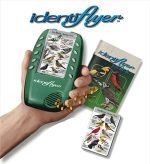 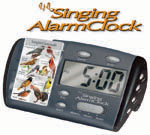
Mike's Message
As 2010 ended, many of you have expressed your concern as to how our store is doing in this current economy. First, thank you for being concerned about our well-being. In a year when many retail stores experienced great losses or had to close their doors, we were able to maintain and with your continued support I pledge to continue striving to bring you excellent products and good advice. Our store remains strong. Thank YOU! I couldn’t make that claim without your support.
Along those lines, after 19 years in our present location, we have decided to relocate our store later this year. The current location has left us void of neighbors and activity and as our lease draws to an end, we will look for a new and exciting, more vibrant location. We have found a few sites, all within close proximity to our current location that might be possibilities. When a decision has been made we will be letting everyone know the “where” and “when”. Again, our business is strong; we are not going out of business, just moving out and up.
We all know these are not easy times. Prices on most everything have been increasing. Our birding world has not been untouched by these higher priced commodities. Copper, the main component in our favorite Bovano pieces, increased 30% last year. Steel, wood and recycled products which make such items as shepherd hooks, bird baths and bird houses, have increased 20-38%. Food is going up and so is bird seed. I belong to an internet group of independent bird store owners across the country and higher seed prices have been the topic for everyone. What causes bird seed to increase? Major fast food chains have bought out nearly the whole sunflower crop as they are trying to become healthier and cook more with sunflower oil. Corn is being bought up for ethanol usage. Soybeans and wheat are in high demand so farmers are growing those products instead of safflower and millet. I can only promise that I will keep my seed prices as low as I can to give you the best price and still stay in business.
On a happier note, as stated in this newsletter, we are celebrating our 11 year store anniversary. THANK YOU. This store and serving you, my great customers, are still an absolute joy for me and I love absolutely every minute (well almost every minute) of being here for you. Spring is coming, the birds have started chirping and courting and soon our yards will be filled with our migrating feathered friends. Life is good in our backyard! Happy Birding, Mike
Special Customer Coupons!
|